-
Products
- Local Securities
- China Connect
- Grade Based Margin
- Stock Borrowing & Lending
- IPO
- Stock Options
- Foreign Stocks
- Unit Trust
- Local Futures
- Foreign Futures
- Forex
- Bullion
- Insurance Services
- Bond
- Monthly Investment Plan
- Mortgage
- Other Services
- Surplus Cash Facility
- Phillip Premier
- Latest Insurance Promotion<
- ETF
- Smart Minor (Joint) Account
- Capital Management
- Research
- Market Info
- Education Center
- Phillip Apps
- Customer Service
- About Us
-
Surplus Cash Facility
Research Report
Huadian Power Int`l (1071.HK) - Low valuations, but weak earnings
Thursday, May 4, 2017  17291
17291
Huadian Power Int`l(1071)
| Recommendation | Accumulate |
| Price on Recommendation Date | $3.280 |
| Target Price | $3.670 |
Weekly Special - 002085.SZ Wanfeng Auto Wheel
Investment Summary
-Due to significant increase in coal price, continuous decrease in utilisation hours, and coal power tariff cut, the firm posted a weak FY2016 result.
-The firm's valuation is attractive, since its current PB ratio were significantly lower than the 10 years average. The FY2016 ROE was only slightly lower than its 10 years average.
-China's power consumption accelerates in Q1 2017, eased the overcapacity problem. China's coal price remains the biggest uncertainty for the firm.
Company Overview
Huadian Power International Corporation Limited mainly engaged in generation and sales of electricity and heat, sales of coal and other relevant businesses in the PRC. All electricity generated supplied to the grid companies where the plants are located. Acorrding to the FY2016 result, the group had a total of 61 controlled power plants which have commenced operation. The Group's total controlled installed capacity amounted to 48,139.7MW, of which 42,966.5MW was attributable to controlled coal- and gas-fired generating units, and 5,173.2MW was attributable to controlled renewable energy generating units such as hydropower, wind power, solar power and biomass energy power generating units. According to the 2016 annual report, the group managed to achieve power generation of approximately 190.06 million MWh, representing a increase of approximately 4.15% YoY, and sales of heat amounting to 69.72 million Gj, representing a increase of approximately 9.46% YoY. The Group achieved a revenue of approximately RMB62.837 billion, profit for the year attributable to equity shareholders of the Company of approximately RMB3.128 billion, and basic earnings per share of approximately RMB0.317, indicated the current PE ratio is only approximately 9.27x. Book value per share was approximately RMB 4.44. The Board proposes to declare a final cash dividend of RMB0.136 per share, which means the stock provides a dividend yield of approximately 4.61%.
Due to significant increase in coal price, continuous decrease in utilisation hours, and coal power tariff cut, the firm posted a weak FY2016 results. Since China coal prices in the first quarter of 2017 were still high, the firm also announced a weak 2017 first quarter result. The Company's net profit attributable to the equity shareholders of the Company for the First Quarter amounted to RMB11.836 million, representing a decrease of 99.35% YoY, as expected, mainly due to a significant decrease in the profit of the Company as a result of the increase in coal price. On the other hand, the group's cash flow is still abundant. The net cash inflow generated from operating activities for the first quarter amounted to RMB2,302 million, representing a decrease of 65.33% YoY, mainly due to the increase in the cost of fuel purchased by the company as a result of the increase in coal price. Although we are not optimistic about the 2017 first half result, the stock is trading at only approximate 0.63x Price to Book Ratio, the stock had underperformed by approximately 34% compared with the Hang Seng Index, which the valuation might already become appealing.
Peer Comparison
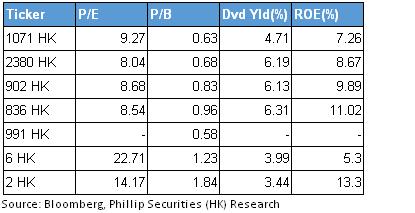
The table in above shows the peer comparison of the group.
In term of PE and PB, the group is less expensive than its international peers such as Power Asset Holdings (6 HK) and CLP Holdings (2HK).
In term of PB, the valuation is lower than its peers such as Huaneng Power (902 HK), China Power (2380 HK),and China Resources Power (836 HK). However, the earning power was weaker than its peers and dividend yield was also lower.
The Valuation is attractive, the stock trades at significant below its 10 years PB average
The chart below shows 10 years of PB ratio of the stock, the statistic started on 25/4/2007, with 2 standard deviations.
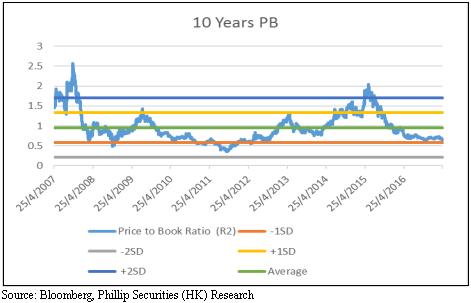
From the chart above, we can see that the PB valuation is significantly lower than the 10 years average. The average 10 years PB ratio is approximately 0.95x, one standard deviation below is 0.58x, and the stock trades significantly below the 10 years average but above 1 standard deviation. From the 10 years PB chart, we can see that the PB valuation of the stock is extremely fluctuate, but since it is trading at significant below the 10 years average, the downside risk possibly limited.
The Return on Equity ratio is also crucial, which can provide more information regarding the profitability of the group. The chart in below shows the 10 years ROEs of the firm.
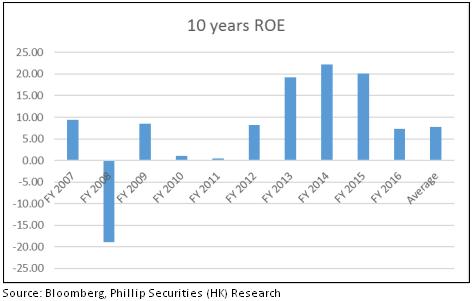
According to the bar chart in above, the FY2016 ROE was 7.26%, which is slightly lower than the 10 years average ROE of 7.75%, indicating that the profitability is still acceptable for the period. Moreover, the stock trades at only around 0.63x PB ratio currently, which is significant below its 10 years PB average, but the ROE is slightly lower than its 10 years average ROE. This could indicated the stock has possibly become undervalued.
Moreover, we used a simple Discounted Dividend Model for evaluating the intrinsic value of the firm. We use The annual market return of HSI that we use for the calculation is 7.16%, figures are collected from 31th Dec 1995 to 31th DEC 2016. We used the 10 years China government bond yield of 3.42% as the risk free rate, and the historical Beta of the stock is 0.87. From that, we calculated that the required return of the stock is 6.66%. We expected the FY2017 dividend per share will be RMB0.09 per share. Our prudently forecasted dividend per share for next year is 0.12 RMB per share. Basic on the 10 years average ROE figure, and the dividend payout ratio will stays the same as 40%, we prudently estimated that the dividend growth rate is 3.1%. As a result, the intrinsic value of the stock is approximately RMB 3.25 per share under our prudent assumptions, which is more than 10% higher than its current share price. Therefore, the downside risk of the stock is possibly limited.
China's power consumption accelerates in Q1
According to the National Development and Reform Commission, Power consumption rose 6.9% YoY in the first three quarters of this year, 3.7% higher than the same period last year. In 2016, the power industry in China experienced a complicated and changing market environment. In 2016, the national total electricity consumption rose by 5.0% YoY. Although the growth rate increased significantly as compared with 2015, the national power generation installed capacity as at the end of 2016 recorded a year-on-year increase of 8.2%, which was even higher than the growth rate of national total electricity consumption, indicating an oversupply of national power supply. The higher power consumption in Q1, should ease the overcapacity issue in China.
China Coal Price remains the biggest uncertainty for the firm
Since the China government has been implemented a successful coal supply-side structural reform, including the strictly production limitation and reduction policy in major coal producing areas, as well as intensified the inspection on illegal coal mines and closure and suspension of mines. In 2016, the coal price increased roughly more than 60%, according to the China Nationwide Thermal Coal Price index.
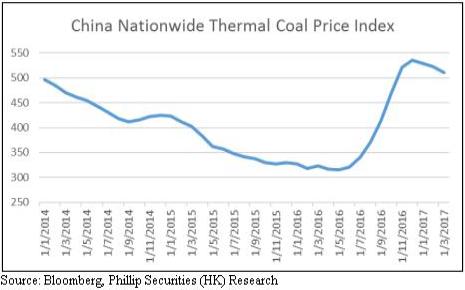
However, the significant price increases disrupted the coal industry's capacity reduction and hurt the business of downstream industries, could cause the serious excess capacity problem reappeared in the coal industry. On the demand side, the end of the winter heating season will also reduce the demand for Coal. The China Nationwide Thermal Coal Price Index dropped slightly to 511.29 per tonne in Mar 2017, which decreased for 3 consecutive months. Moreover, According to a report released by Cqcoal on 26/04/2017, the Bohai-Rim Steam-Coal Price Index (BSPI), a leading indicator for Chinese coal prices, decreased for 5 consecutive weeks to 598RMB per tonne. As a result, if the coal price continue to drop, we believe the group's earning power will improve in the future.
Valuation
Taking all the points mentioned above into consideration, Huadian Power International Corporation Limited's target price is therefore $3.67, with Accumulate rating assigned, represents 0.70x FY17 P/B and 0.68x FY18 P/B. (Closing price as at 28 April 2017)
Risks
-Risks relating to the power demand in China, the overall power demand could keep declining if the economic growth slows down.
-Risks relating to coal market, the fluctuation on the coal price will bring certain degree of risks to the fuel cost control.
--Risks relating to electricity tariff, it could cause uncertainty on the firm's revenue.
-Risks relating to environmental protection policies, the national standards for energy saving environmental protection could pushed higher and the environmental protection restrictions for energy development is possibly more tightened.
Financials
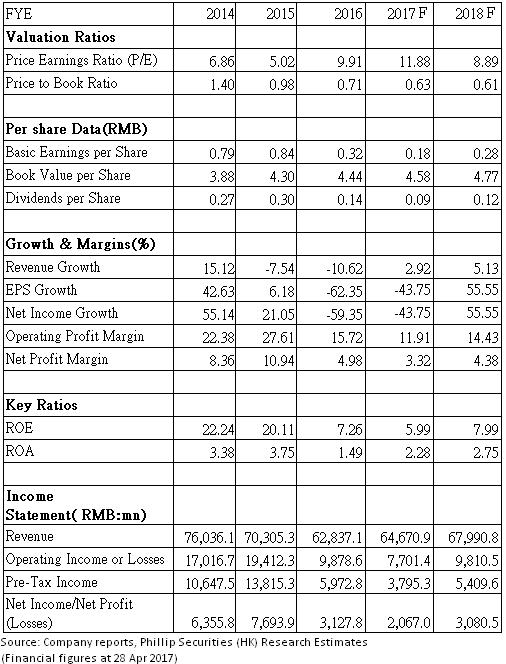
This report is produced and is being distributed in Hong Kong by Phillip Securities Group with the Securities and Futures Commission (“SFC”) licence under Phillip Securities (HK) LTD and/ or Phillip Commodities (HK) LTD (“Phillip”). Information contained herein is based on sources that Phillip believed to be accurate. Phillip does not bear responsibility for any loss occasioned by reliance placed upon the contents hereof. The information is for informative purposes only and is not intended to or create/induce the creation of any binding legal relations. The information provided do not constitute investment advice, solicitation, purchase or sell any investment product(s). Investments are subject to investment risks including possible loss of the principal amount invested. You should refer to your Financial Advisor for investment advice based on your investment experience, financial situation, any of your particular needs and risk preference. For details of different product's risks, please visit the Risk Disclosures Statement on http://www.phillip.com.hk. Phillip (or employees) may have positions/ interests in relevant investment products. Phillip (or one of its affiliates) may from time to time provide services for, or solicit services or other business from, any company mentioned in this report. The above information is owned by Phillip and protected by copyright and intellectual property Laws. It may not be reproduced, distributed or published for any purpose without prior written consent from Phillip.
Top of Page
|
Please contact your account executive or call us now. Research Department Tel : (852) 2277 6846 Fax : (852) 2277 6565 Email : businessenquiry@phillip.com.hk Enquiry & Support Branches The Complaint Procedures |
About Us Phillip Securities Group Join Us Phillip Network Phillip Post Phillip Channel Latest Promotion 新闻稿 |
E-Check Login |
Investor Notes Free Subscribe |

|




